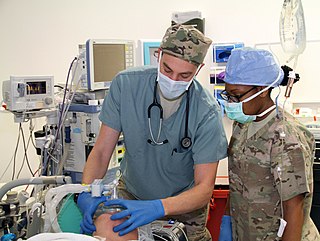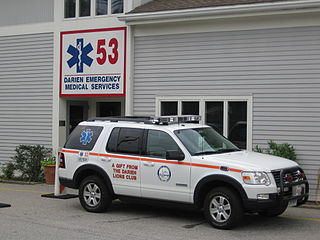
Emergency medical services (EMS), also known as ambulance services or paramedic services, are emergency services that provide urgent pre-hospital treatment and stabilisation for serious illness and injuries and transport to definitive care. They may also be known as a first aid squad, FAST squad, emergency squad, ambulance squad, ambulance corps, life squad or by other initialisms such as EMAS or EMARS.

A paramedic is a health care professional whose primary role is to provide advanced emergency medical care for critical and emergent patients who access the emergency medical system. This individual possesses the complex knowledge and skills necessary to independently provide patient assessment and care in the out-of-hospital setting. The Paramedic extends the traditional capabilities of a hospital emergency department into the field.
Peter Safar was an Austrian anesthesiologist of Czech descent. He is credited with pioneering cardiopulmonary resuscitation (CPR).

Anesthesiology, anaesthesiology, anaesthesia or anaesthetics is the medical specialty concerned with the total perioperative care of patients before, during and after surgery. It encompasses anesthesia, intensive care medicine, critical emergency medicine, and pain medicine. A physician specialised in this field of medicine is called an anesthesiologist, anaesthesiologist or anaesthetist, depending on the country.
A medical director is a physician who provides guidance and leadership on the use of medicine in a healthcare organization. These include the emergency medical services, hospital departments, blood banks, clinical teaching services and others. A medical director devises the protocols and guidelines for the clinical staff and evaluates them while they are in use.

The University of Pittsburgh Medical Center (UPMC) is a $21 billion integrated global nonprofit health enterprise that has 89,000 employees, 40 hospitals with more than 8,000 licensed beds, 700 clinical locations including outpatient sites and doctors' offices, a 3.7 million-member health insurance division, as well as commercial and international ventures. It is closely affiliated with its academic partner, the University of Pittsburgh. It is considered a leading American health care provider, as its flagship facilities have ranked in U.S. News & World Report "Honor Roll" of the approximately 15 to 20 best hospitals in America for over 15 years. As of 2016, flagship hospital, UPMC Presbyterian is ranked 12th nationally among the best hospitals by U.S. News & World Report and ranked in 15 of 16 specialty areas when including UPMC Magee-Womens Hospital. This does not include UPMC Children's Hospital of Pittsburgh which ranked in the top 10 of pediatric centers in a separate US News ranking.
The University of Pittsburgh School of Dental Medicine is the dental school of the University of Pittsburgh (Pitt). It is located in Pittsburgh, Pennsylvania, United States. It is one of Pitt's six schools of the health sciences and one of several dental schools in Pennsylvania. It is closely affiliated with the University of Pittsburgh Medical Center. The School of Dental Medicine accepted 3.6% of applicants for the class of 2016, a record low for the school's entire history.

In the United States, the paramedic is a professional whose primary focus is to provide advanced emergency medical care for critical and emergency patients who access Emergency Medical Services (EMS). This individual possesses the complex knowledge and skills necessary to provide patient care and transportation. Paramedics function as part of a comprehensive EMS response, under medical oversight. Paramedics perform interventions with the basic and advanced equipment typically found on an ambulance. The paramedic is a link from the scene into the health care system. One of the eligibility requirements for state certification or licensure requires successful completion of a nationally accredited Paramedic program at the certificate or associate degree level. Each state varies in requirements to practice as a paramedic, and not all states require licensure.

Jacobi Medical Center is a municipal hospital operated by NYC Health + Hospitals in affiliation with the Albert Einstein College of Medicine. The facility is located in the Morris Park neighborhood of the Bronx, New York City. It is named in honor of German physician Abraham Jacobi, who is regarded as the father of American pediatrics.

UPMC St. Margaret is a mid-sized, acute care, teaching community hospital of the University of Pittsburgh Medical Center, located in Aspinwall, Pennsylvania. Situated on 21 acres (8.5 ha), the hospital has 249 beds with more than 800 physicians and 1,500 clinical staff members. In March 2009, UPMC St. Margaret achieved Magnet Recognition status. Magnet status is the highest international recognition for nursing excellence and leadership.

STAT MedEvac is a service of the Center for Emergency Medicine of Western Pennsylvania in Pittsburgh, Pennsylvania. The primary function of STAT MedEvac is to provide air medical transport and as of July 2017 two ground ambulances for patients with an injury or critical illness. STAT MedEvac is directed by a consortium of hospitals of the University of Pittsburgh Medical Center (UPMC) that include UPMC Children's Hospital of Pittsburgh, UPMC Altoona, UPMC Hamot, UPMC Mercy and UPMC Presbyterian Shadyside. STAT MedEvac's base of operations is in West Mifflin, Pennsylvania, at the Allegheny County Airport. With 18 helicopter base sites across Pennsylvania, Maryland, New York, Ohio, and the District of Columbia, it is one of the largest single operated and dispatched air-medical transport system in the United States.

In the United States, emergency medical services (EMS) provide out-of-hospital acute medical care and/or transport to definitive care for those in need. They are regulated at the most basic level by the National Highway Traffic Safety Administration, which sets the minimum standards that all states' EMS providers must meet, and regulated more strictly by individual state governments, which often require higher standards from the services they oversee.
Paramedicine is a practice that represents the intersection of health care, public health, and public safety. While discussed for many years, the concept of paramedicine was first formally described in the EMS Agenda for the Future. Paramedicine represents an expansion of the traditional notion of emergency medical services as simply an emergency response system. Paramedicine is the totality of the roles and responsibilities of individuals trained and credentialed as EMS practitioners. These practitioners have been referred to as various levels of Emergency Medical Technician (EMTs). In the United States paramedics represent the highest practitioner level in this domain. Additional practitioner levels in this domain within the U.S. include Emergency Medical Responders (EMRs), Emergency Medical Technicians (EMTs) and Advanced Emergency Medical Technicians (AEMTs).

UPMC Mercy is a main hospital facility of the University of Pittsburgh Medical Center (UPMC) and is located in the Uptown section of the city of Pittsburgh, Pennsylvania, adjacent to Duquesne University, and a few blocks from the PPG Paints Arena and downtown Pittsburgh. It is the first chartered hospital to have been founded in the city of Pittsburgh and it is also the first hospital in the world to have been established by the Sisters of Mercy. It is also the first teaching hospital in the region, accepting residents to teaching positions beginning in 1848, one year after opening its doors.
Anaesthesia, Trauma and Critical Care (ATACC) is an international trauma and anaesthesia organisation.
Air Evac EMS, Inc., operating as Air Evac Lifeteam, is the largest company within AMGH. Air Evac is still the largest independently owned and operated HEMS, or air ambulance provider. Air Evac currently operates helicopters at 131 bases, covering most of the central and southern states; Service Area. While primarily a HEMS provider, they do operate 2 fixed-wing aircraft in Missouri and Kentucky. Originally based in West Plains, Missouri, the headquarters, dispatch (CenComm), and a few other departments were moved to a new facility in O'Fallon, Missouri in 2013.
UPMC Williamsport, formerly UPMC Susquehanna Williamsport or Williamsport Regional Medical Center, is a 24-hr emergency hospital of UPMC Susquenhana located in Williamsport, Pennsylvania. Originally established in 1873 as the Williamsport Hospital, it currently operates at least 224 beds.
The McKeesport Ambulance Rescue Service, formally the McKeesport Ambulance Authority, is a non-profit emergency medical services agency which provides emergency medical and patient transport services to the City of McKeesport and a number of surrounding municipalities. It was established in 1991, and is assigned station number 620 by Allegheny County Emergency Services.

UPMC Presbyterian is a 900-bed non-profit, research and academic hospital located in the Oakland neighborhood of Pittsburgh, Pennsylvania, providing tertiary care for the Western Pennsylvania region and beyond. It comprises the Presbyterian campus of the combined UPMC Presbyterian Shadyside hospital entity. The medical center is a part of the University of Pittsburgh Medical Center health system and is the flagship hospital of the system. UPMC Presbyterian is affiliated with the University of Pittsburgh School of Medicine and is physically conjoined to the medical school's primary facility, Scaife Hall. UPMC Presbyterian is also connected via enclosed pedestrian bridges and tunnels to UPMC Montefiore hospital, UPMC Western Psychiatric Hospital, the Eye & Ear Institute, Falk Clinic, the University of Pittsburgh School of Nursing's Victoria Hall, the University of Pittsburgh's Lothrop Hall student residence, and multiple university biomedical science towers. UPMC Presbyterian also features a state verified Level 1 Trauma Center, 1 of 3 in Pittsburgh. Although UPMC Presbyterian has no pediatric services, Presby has the equipment to stabilize and transfer pediatric emergency cases to the nearby UPMC Children's Hospital of Pittsburgh.

UPMC Shadyside, is a nationally ranked, 520-bed non-profit, tertiary, teaching hospital located in the Shadyside neighborhood of Pittsburgh, Pennsylvania. UPMC Shadyside is a part of the University of Pittsburgh Medical Center (UPMC), and grouped in with the flagship UPMC Presbyterian. The hospital is near UPMC's flagship campus which houses Presbyterian and Montefiore. As the hospital is a teaching hospital, it is affiliated with University of Pittsburgh School of Medicine. The hospital has an emergency room to handle emergencies, with a rooftop helipad to transport critical patients to and from the hospital. UPMC Shadyside houses the flagship campus of the UPMC Hillman Cancer Center, a nationally ranked cancer hospital.













